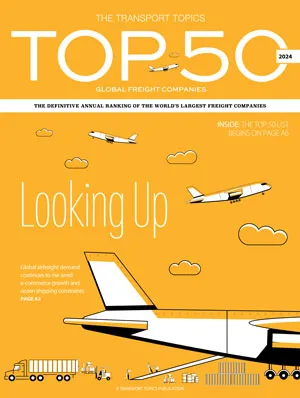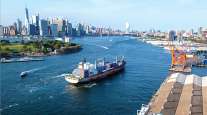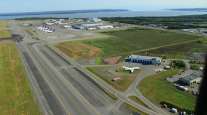Looking Up: Airfreight Demand Takes Off in 2024
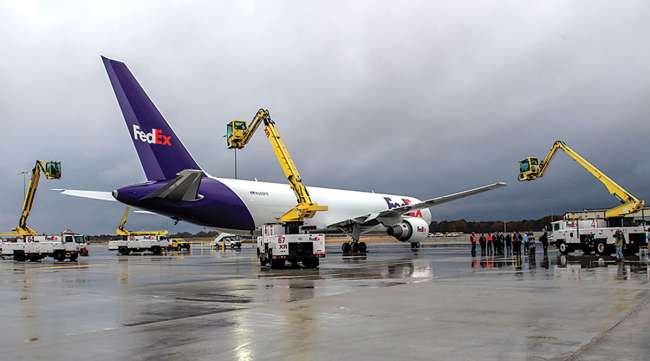
[Stay on top of transportation news: Get TTNews in your inbox.]
Demand for global air cargo traffic continues to increase amid e-commerce growth and ocean shipping constraints, driving prices higher and forcing transportation providers and airports to find new efficiencies to maximize capacity.
According to Matt Castle, vice president of global forwarding at C.H. Robinson Worldwide Inc., the past few years for air freight have been a roller coaster of disruption for shippers who are using air traffic to mitigate the risk of delays associated with ocean shipping.
“Air capacity has been tight for a variety of reasons and costs are the highest we’ve seen since the pandemic,” he added.
C.H. Robinson ranks No. 20 on the Transport Topics 2024 Top 50 Global Freight Companies list.
Airfreight hit record highs during the pandemic amid a surge in e-commerce, which demands faster transit times. Levels decreased after the pandemic-driven disruptions eased, but e-commerce growth has had a lasting impact on airfreight, prompting companies to optimize their logistics for the increased volume of goods requiring rapid transportation, said Katherine Kaczynska, a spokesperson for the International Air Transport Association.
Plus, conflict in the Red Sea has caused some shippers to move freight from ocean to air to avoid the added six weeks of transit time that comes with diverting around the Cape of Good Hope, Castle said.
Lingering airfreight capacity concerns due to ongoing regional conflicts have led to price increases and occasional delays, according to Kent Thompson, vice president of global airfreight for AIT Worldwide Logistics.
Airfreight levels have been growing steadily since 2023, with total traffic nearing the peak reached in December 2021 and showing no signs of slowing down, according to IATA. In July, global air cargo delivered the eighth straight month of double-digit growth.
“Air cargo demand hit record highs year to date in July with strong growth across all regions ranging from 7% to 18% year over ear, year to date,” IATA’s Kaczynska said.
Glyn Hughes, director general of the International Air Cargo Association, said current demand for 2024 is running at approximately a 10% increase versus 2023, but air cargo capacity is only growing at about half that rate, a little under 5%.
Dennis Cancino, vice president of U.S. airfreight at DHL Global Forwarding, said the U.S. airfreight market is stable for both exports and imports, but certain markets are seeing more growth than others.
“The U.S. outbound market to Latin America has seen a slight uptick in volumes, and carriers are passing along general rate increases, but overall capacity continues to be in line with regular demand flows,” he said.
DHL Group ranks No. 5 on TT’s Top 50 list.
E-commerce from Asia, which typically is shipped via air, is in such high demand that carriers are shifting capacity from other trade lanes to the booming markets, C.H. Robinson’s Castle noted.
Meanwhile, air passenger traffic has rebounded to pre-pandemic levels, even exceeding it in some lanes, which is adding belly cargo capacity. Unfortunately, the added capacity doesn’t always reflect where the cargo demand is, and it can be challenging to match supply with demand.
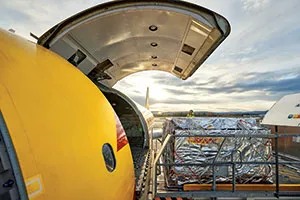
Airfreight demand is up about 10% from last year, but capacity is only growing at about half that rate. (DHL Group)
“Currently, we are seeing huge demand from Asia to Europe, North America and the Middle East. This demand far exceeds available belly capacity, so freighters are the main source of cargo capacity,” IACA’s Hughes said. “However, demand into Asia isn’t at the same level so operational challenges exist to get the capacity positioned in a cost-effective manner.”
The primary difference between the passenger business and the cargo business is bidirectional versus unidirectional transport, which, according to Hughes, means that cargo demand can only be satisfied through enhanced global networks based on increased connectivity.
Adding Capacity
DHL has added capacity at several airports globally to expand its network. The company recently tripled its operational capacity with a new facility at Francisco Sá Carneiro Airport in Porto, Portugal.
AIT Worldwide Logistics is also increasing its footprint, developing its partner network and strengthening procurement in emerging markets by introducing additional peak-season air cargo capacity from October until December via weekly flights between Hong Kong and Los Angeles, Thompson said.
Additionally, airports are investing in cargo infrastructure to add capacity and keep up with evolving product mixes.
“Currently, we see increases in demand for perishables, pharmaceuticals, high-tech electronics and e-commerce products,” Hughes said. “Each of these verticals requires different handling standards and operations, so facilities must evolve and adapt to changing conditions.”
Ted Stevens Anchorage Airport is expanding its cargo hardstands — paved areas to park aircraft — working with third-party developers interested in building facilities for perishable goods such as peonies and seafood, and keeping up with e-commerce needs.
“We’ve seen steady growth from companies like Amazon, which continues to expand its operations to meet increasing demand,” said Angela Spear, airport director.
Dan Mann, executive director of the Louisville Regional Airport Authority, said the airport will be building out capital projects over the next three years. The challenge is that the airport has a somewhat constrained airfield with a Ford plant to the south and a railroad to the east.
McLeod Software CEO Tom McLeod explores the potential for artificial intelligence to boost efficiency and build resilience. Tune in above or by going to RoadSigns.ttnews.com.
“Everything we do in infrastructure is about how we improve the efficiency of the airfield,” Mann said. “One of the projects we’re doing is a cross-field taxiway primarily so the cargo can get from the west side of the airfield to the east side as quickly as possible.”
The Louisville airport is a major hub for UPS Inc. Earlier this year, UPS was awarded a significant air cargo contract by the U.S. Postal Service, creating double-digit increases in cargo at the Louisville airport since mid-July, Mann said. He added that UPS continues to invest in its operations there, building a $200 million hangar to turn aircraft quicker and adding more than 20 new 747 aircraft. UPS, which ranks No. 3 on the Top 50 list, declined to comment for the story.
Airports also are finding innovative ways to increase capacity without adding runways. The Louisville airport bought nine multifunction pieces of snow equipment that have a 22-foot plow with a broom in the middle to speed up snow removal.
“What took 45 minutes now takes 20 minutes,” Mann said. “When you have cargo going around the world and you can have that runway open twice as fast, it is significant.”
The Memphis Airport Authority opened a centralized deicing facility in late 2022.
“This facility provides a centralized area for our passenger and cargo aircraft to perform their deicing operations before takeoff. This has helped FedEx to be more efficient with its operations,” said Glen Thomas, director of strategic marketing and communications for Memphis International Airport.
FedEx, which ranks No. 2 on the Top 50 list, represents about 99% of cargo at the Memphis airport but declined to comment.
Mann noted that maintaining an airfield with 24/7 operations can be a challenge.
“We have very close ties with UPS, and we coordinate a year in advance on runway closures and have constant coordination,” he said. “We can’t close the runway for 90 days. We must do it in short increments.”
Turning to Technology
Technology is helping providers streamline freight movements. IATA’s Kaczynska noted the industry has accelerated the adoption of technologies such as better tracking systems, automated processes and advanced data analytics to optimize routes and loads.
Everything we do in infrastructure is about how we improve the efficiency of the airfield.
Dan Mann, Louisville Regional Port Authority
Image
AIT Logistics uses artificial intelligence to predict freight forwarding issues before they occur and intervene proactively. Patrick Chew, vice president of AI and data science for the company, said that AI will be trained to prompt, inform, recalibrate and prescribe the best alternatives for air cargo routes.
“The model will also factor in airport locality, sustainability considerations, safety and historical performance in terms of efficiency and reliability,” he added.
AIT leverages round-the-clock AI and robotic process automation technology to optimize critical processes, including routing, flight updates, customs clearance and financial operations. In addition to optimizing transport, AI and RPA can reduce emissions, improve data security and boost the overall experience for customers and teammates, explained Chris McMillin, vice president of global business systems at AIT.
Hughes, from the International Air Cargo Association, expects to see autonomous solutions for ramp vehicles, smart storage and retrieval systems, airport monitoring, and first-, middle- and last-mile distribution.
Ted Stevens Anchorage International’s sister airport, Fairbanks International Airport, has been a hub for testing various autonomous technologies, including an unmanned aircraft system and a pilot study on unmanned cargo aircraft.
“These tests aim to deliver critical fuel and freight to remote areas of Alaska that aren’t connected to the road system,” Spear said.
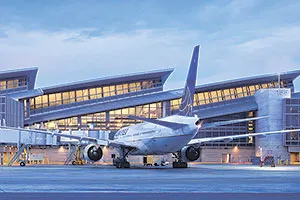
Airports like LAX have been adopting new technologies to optimize routes and increase efficiency. (Los Angeles International Airport)
One project — a 72-pound robotic quadruped — can be operated either by people or autonomously and will document migratory bird species. In collaboration with a wildlife biologist, it will employ non-lethal methods to manage wildlife activity since migratory birds present a significant hazard to aircraft safety.
Andrew Schadegg, vice president of life sciences in North America for AIT, said tracking technology has improved significantly, which is essential for temperature-sensitive freight. The company’s life sciences division deploys devices that continuously transmit information about location, temperature, humidity and other metrics.
“Likewise, temperature monitoring devices are increasingly prevalent for our food logistics operations as that industry has become more tightly regulated,” he said.
The life sciences division also uses advanced technology thermal blankets for pharmaceutical shipments and on certain lanes and can request specific temperature ranges in aircraft compartments.
DHL continues to add technology to its operations and warehouse process to enhance visibility and overall speed of recovery, breakdown and availability.
“Additionally, we continue to develop and enhance our office flows through technology builds into our transportation management system with the aim of driving efficiency in our processes,” Cancino said.
Going Green
Improving efficiency can create sustainability benefits, which are increasingly important to airfreight providers.
Ted Stevens Anchorage International Airport recently secured a federal grant to conduct a study on sustainable aviation fuel, including production, transportation and storage, to explore potential options for airlines in Alaska.
“When an issue is important to our carriers, it’s our responsibility to evaluate how we can offer support,” Spear said.
However, sustainable aviation fuel is only available in small quantities, accounting for about 1% to 2% of global demand.
Want more news? Listen to today's daily briefing above or go here for more info
“Much more investment is required by the energy sector, supported by government incentives to create the quantities needed to help the aviation industry achieve its net zero objective by 2025,” Hughes said.
AIT participates in a sustainable aviation fuel program with KLM and received KLM’s Air Freight Enterprise Sustainability Award in 2023. The company also has adopted reusable packaging for server rack shipments and transitioned away from polystyrene to fully recyclable paper-insulated containers for food logistics, said Matt Sanders, AIT’s director of communications.
Selecting the Right Mode
Much of the freight being moved by air right now doesn’t need to be.
“Many times, shipping via ocean could be a viable option. The urgency comes down to business pressures, not supply chain ones,” Castle said. “So, we are helping our customers adjust and ensure their shipping strategy is aligned with their business model and priorities.”
Often, this can include adjusting warehousing strategies or shifting modes. Castle added that forecasting has become increasingly difficult as the prolonged air peak continues, so logistics providers must be ready to help customers pivot if needed.
Capacity is expected to remain tight, and the ongoing demand for air freight can bring increased risks.
Castle said C.H. Robinson is helping customers build contingency plans.
“Shippers have accepted the elevated air costs as the new normal, but it’s not sustainable,” he said. “Evaluating which freight is truly urgent and selecting modes accordingly is key to cost savings and resiliency.”


